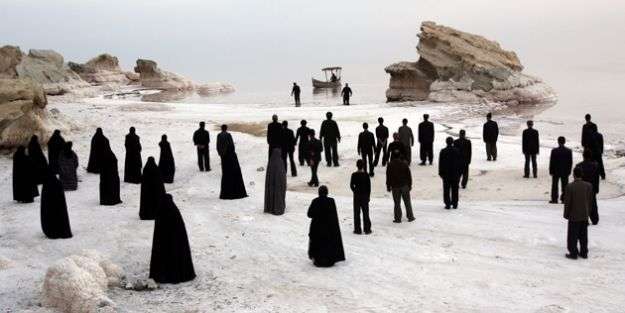CHRIS KNIPP'S SFIFF COVERAGE ON FILMLEAF
HERE.
 Rituals and allegories of repression and loss
Rituals and allegories of repression and lossThis is a new film by the Iranian director of the 2005
Iron Island. Rousoulof is a filmmaker with a very unique vision whose allegorical storytelling method buries its political references generally deeply enough to justify pondering and avoid obviousnessness. This time he focuses on Rahmat (Hassan Pourshirazi), a traveling collector of people's tears who rows around an island region of Iran full of salt deposits. It's a magical, primitive world worthy of Jodorowsky, or some other maker of fabulous myths on film. It's all in the images here, and the solemn rituals. Working amid the bleached out, haunted looking islands and salt formations of Iran's Lake Urmia Rasoulof has again made remarkable use of authentic looking local people whose ancient faces and clothes evoke Italian neorealism with a Middle Eastern touch.
Rahmat rows his small boat from one community to another where he encounters weeping women and formally gathers their tears in a tiny retort and funnels them into a flask. All the people he encounters are burdened with suffering and sadness, their tears echoing the salt everywhere in the environment. First Rahmat finds a community mourning the death of a young women, but they say it was for the best because she moved so provocatively and even looked men in the eye -- a plain enough reference to fundamentalist Islamic repression of women. In another place men tell their woes into jars which they shut. The jars are tied around the body of a dwarf Khojatesh (Omid Zare) and then-- filled with fear and trepidation -- he is lowered into a well to please a fairy at the bottom of it. At another place, the most beautiful girl in the community is dressed as a bride and sent out to sea to appease the gods who have withheld the rain. Her corpse is then given to Rahmat to take away. But when he pulls off the shroud, curious to see the girl's face, he finds a living boy, Nassim (Younes Ghazali), who has stowed himself away because he wants to seek his lost father, a shepherd who went off to sea. Rahmat allows him to come along on his rounds with the proviso that when they're around other people he must pretend to be deaf and dumb -- in part so women will feel free to spill out their woes. Later the boy is stoned for his curiosity and taken away on the boat nearly dead. His wounds hurt him and his mouth is dry, but Rahmat says if he drinks he will die.
In an allegory that is perhaps a bit too blunt, Rahmat encounters an artist buried up o the neck in sand, who is subsequently punished and sent into exile because he doesn't see colors as others see them. He has painted the sea red, and he must learn to see it as blue. When one cure fails he is treated with blinding monkey urine to make his eyes see right. A bearded and long-haired guardian with a lookout hut high on a tiny salt hill receives this prisoner off of Rahmat's rowboat. He also receives the boy Nessim, who turns out the next morning to have died. The bearded one afterward spends his days tormenting the artist, making him run up and down a hill and chanting "the sea is blue, the sea is blue." An episode of a monkey bride seems far-fetched and a little silly, but continues the fairy-tale strangeness of the mood.
With its focus on the wandering collector of tears, a kind of primitive practitioner of group psychotherapy, and its haunting background of salt-soaked land and seascapes,
The White Meadows has more poetry and beauty of images than
Iron Island but, I think, less power. The new film lacks the previous feature's raw immediacy and sense of collectivity, qualities achieved through the rough setting of the decaying ship and the sunni ethnic Arab Bandaris non-actor cast. I also miss the ambiguous relationship between the ship's arbitrary captain and his crew or citizenry. It would have been nice if Rahmat's healing function were made more ironic in
White Meadows, if his relationship to the people he services had more tension in it. However the new film is a feast of images to wander in and ponder and come back to, and its tactile sense in the minute, careful actions Rahmat performs with the tools of an evidently ancient trade focus beautifully on the ambiguity of ritual as both healing comfort and numbing distraction.
The White Meadows is visually splendid and its bizarre inventions make a strong impression that may outlast contemporary political allegories. The narrative has been linked with the Odyssey, but one might do better to think of the
Thousand and One Nights. The White Meadows/Keshtzar haye sepid (in Farsi) received its North American premiere at the Tribeca Film Festival, whose program notes, "On March 2, 2010, Mohammad Rasoulof was arrested in Iran along with prominent filmmaker Jafar Panahi and 14 others as part of the recent crackdown in response to post-election disputes." But Rasoulof has been released, while Panahi remains behind bars. Rasoulof's previous film,
Head Wind (2008), documenting the uncertain fate of satellite disks in Iran, was a commentary on repression of contact with the outside.
Seen at the San Francisco International Film Festival 2010.





